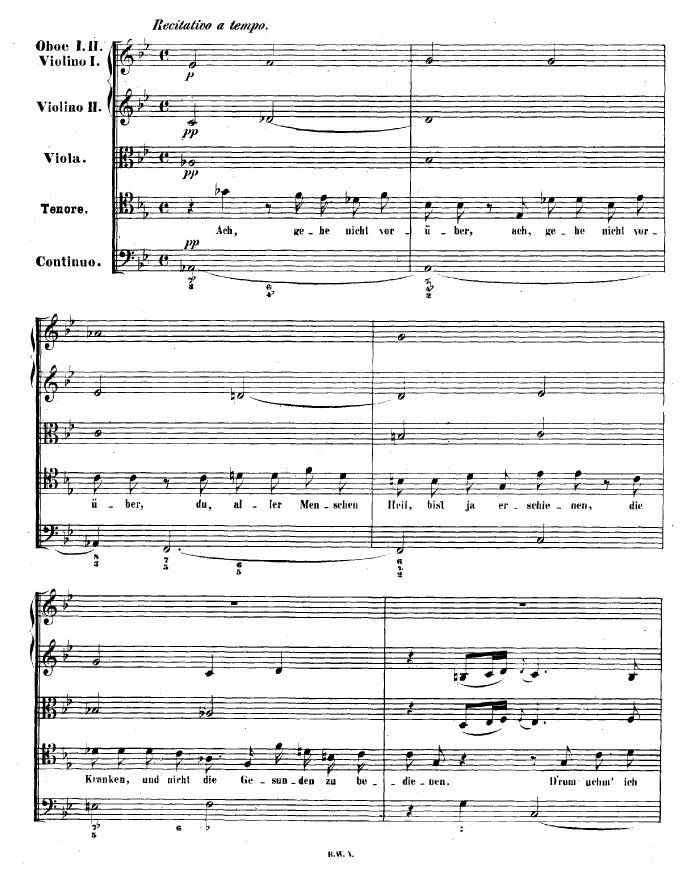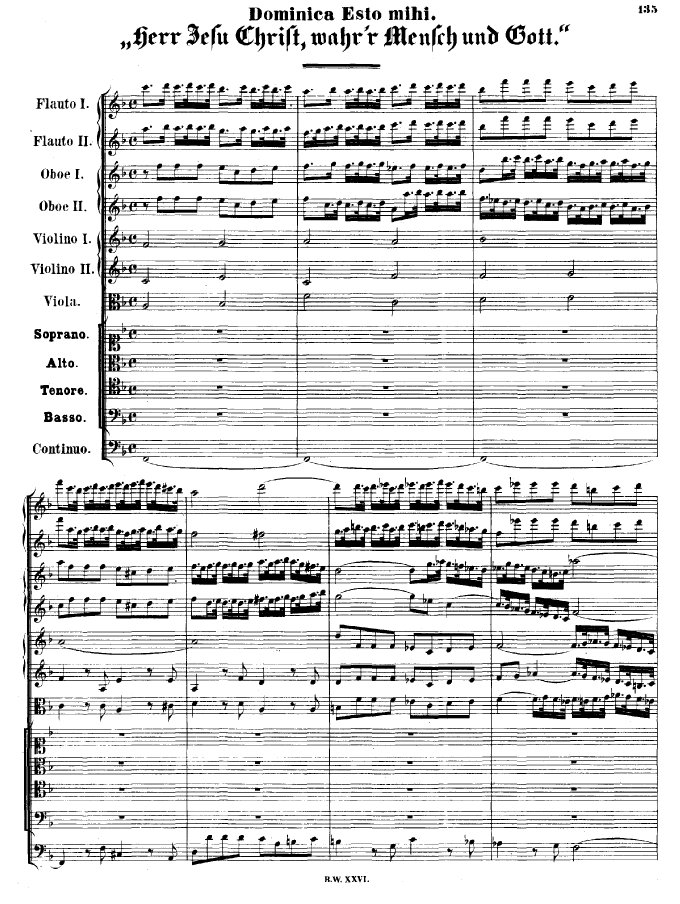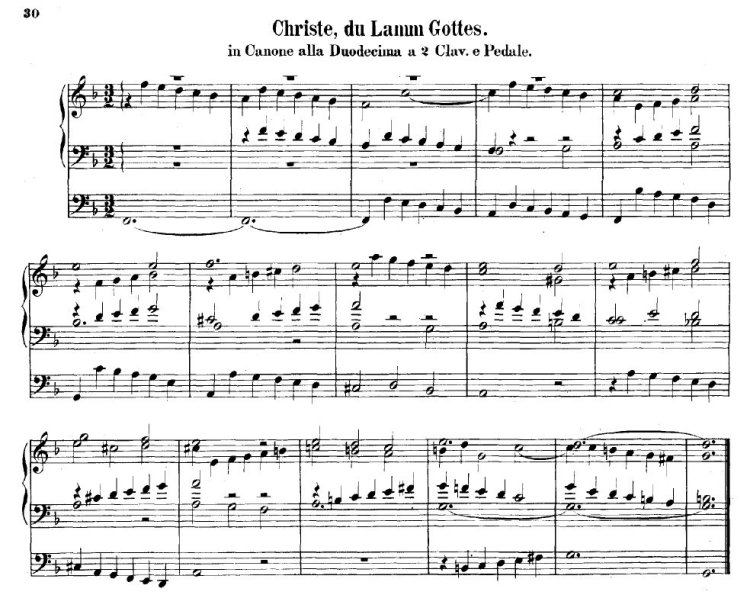|
Chorale Melodies used in Bach's Vocal Works
Christe, du Lamm Gottes |
|
Melody & Text | Use of the CM by Bach | Use of the CM by other composers |
| |
|
Melody & Text: |
|
"Christe, du Lamm Gottes" (Christ, you Lamb of God) is a Lutheran hymn, often referred to as the German Agnus Dei. Martin Luther derived the words as a translation of the Latin Agnus Dei from the liturgy of the mass, and the tune from an older model. The hymn was first published in 1528. It has been the basis for several musical settings by composers such as J.S. Bach, Felix Mendelssohn and Kurt Hessenberg. It appears in the current German hymnals, both the Protestant Evangelisches Gesangbuch (EG 190:2) and the Catholic Gotteslob (GL 208).
When Luther introduced the Reformation, he tried to keep much of the order of the mass, but in German. He published in 1526 Deutsche Messe, an alternative liturgy for a Gottesdienst (church service) in German, which was first sung in Advent of 1525 (See: Luther's Deutsche Messe, Other Liturgical Chorales). It did not contain the liturgical parts Credo and Agnus Dei as translations from the Latin, but different German hymns instead. The translation of the Agnus Dei would instead be sung during communion, alternatively "Jesus Christus, unser Heiland", which eventually was preferred as teaching more.
The hymn appeared with the tune first in Bugenhagen's Braunschweig order of church service, printed in Wittenberg in 1528. The number in the current Protestant hymnal Evangelisches Gesangbuch (EG) is 190:2. In the current Gotteslob, it appears as GL 208, with a slightly different melody.
Source: Wikipedia | IFPS |
|
Melody: Zahn 58
Composer: Martin Luther (1528) |
|
The scholar Robin A. Leaver points out that Luther used in his Deutsche Messe the tune of the Kyrie also to the German Agnus Dei, achieving symmetry. It is Gregorian chant in the first mode (Dorian). Leaver notes that the melody was not printed with the hymn until 1528, but that it was implied already in the Deutsche Messe.
The hymn is featured, often in elaborate settings, by composers through the centuries. J.S. Bach used it several times, notably in a complex setting, which he first used in the lost Weimarer Passion, then in his cantata for the last Sunday before Lent Du wahrer Gott und Davids Sohn, BWV 23, then in the second version of his St John Passion. J.S. Bach composed a chorale prelude (as a canon at the twelfth interval) (BWV 619) as part of his Orgelbüchlein. |
 |
|
Text: Christe, du Lamm Gottes (EG 190.2; GL 208)
Author: German Agnus Dei (mittelalterlich; Braunschweig, 1528) |
| |
| |
|
Use of the Chorale Melody by Bach: |
|
Text: Christe, du Lamm Gottes |
|
Recitative for Tenor with Instrumental Chorale [T] Ach! gehe nicht vorüber (Mvt. 2) from Cantata BWV 23 |
|
Bach introduces the melody into the accompaniment of the Tenor Recitativo, “Ach, gehe nicht voruber,” where the Violins and Oboes have it (B.G. v. (i) 104). He employs it in the same manner (Oboes and Horns) in the accompaniment of the “Kyrie” of the Mass in F major (B.G. viii. 3).
Source: Charles Sanford Terry: Bach’s Chorals. Part I: 2 The Hymns and Hymn Melodies of the Cantatas and Motetts (Cambridge University Press, 1915-1921), pp 185-186 |
 |
|
Chorale Christe, du Lamm Gottes (Mvt. 4) from Cantata BWV 23 |
|
In the concluding Choral Bach uses the melody and words of the Antiphon, “Christe, du Lamm Gottes.” Words and melody appear together in the Pfalz-Neuburg Kirchenordnung (Nurnberg, 1557), and obviously have a pre-Reformation association. The movement originally was the concluding number of the “St John Passion.”
Form. Choral Fantasia (Cornetto, 3 Trombones, 2 Ob., Strings, Continuo). Neither the Choralgesange nor Erk prints the melody.
Source: Charles Sanford Terry: Bach’s Chorals. Part I: 2 The Hymns and Hymn Melodies of the Cantatas and Motetts (Cambridge University Press, 1915-1921), pp 185-186 |
 |
|
Chorus Herr Jesu Christ, wahr Mensch und Gott (Mvt. 1) from Cantata BWV 127 |
|
See: Commentary & Score Examples of Mvt.1: The The Chorale Melody and Text | Part 1 | Part 2 | Part 3 | Part 4 | Part 5 | Part 6 | Melody Variants |
 |
|
Chorus Kyrie eleison. Christe eleison. Kyrie eleison (Mvt. 1) from Mass in F major, BWV 233 |
 |
|
Closing Chorale Christe, du Lamm Gottes (Mvt. 40) from Johannes-Passion BWV 245 (2nd version, 1725) |
|
Similar to BWV 23/4. |
| |
| |
|
Untexted: |
|
Chorale Prelude Christe, du Lamm Gottes, BWV 619 |
|
The “Agnus Dei” is a petition to Christ for forgiveness and pity. Bach also sees the Cross, thrice pictured in the three clauses of the hymn, and weaves round it poignant harmonies indicative of Christ’s suffering.
Source: Charles Sanford Terry: Johann Sebastian Bach, Bach’s Chorals, vol. 3 The Hymns and Hymn Melodies of the Organ Works (1921), pp 114-115 |
 |
| |
| |
|
Use of the Chorale Melody by other composers: |
|
Felix Mendelssohn composed a chorale cantata for choir and orchestra. Kurt Hessenberg composed a five-part motet, published in 1951. |
| |
| |
|
Sources: Bach Digital; BGA; Zahn
Prepared by Aryeh Oron (October 2018) |